Joseph Cockshoot Co. Ltd.
| Joseph Cockshoot Co. Ltd. | |
|---|---|
| legal form | Limited Company |
| founding | 1844 |
| resolution | 1968 |
| Reason for dissolution | Takeover by the Lex Group |
| Seat | Manchester , UK |
| Branch | Body shop |
Joseph Cockshoot Co. Ltd. (short: Cockshoot ) was a wheelwright from Manchester who manufactured high-quality carriages in the 19th century and individual bodies for luxury automobiles in the first half of the 20th century. Cockshoot was considered one of the most prestigious among the British bodywork manufacturers who were not based in the British capital.
Company history
The company was founded by Joseph Cockshoot. In the 1840s he had initially worked for his uncle, who ran a company specializing in cab production. In 1844 Joseph Cockshoot set up his own company in Manchester as a coach manufacturer. According to one source, he founded a new company; others say he took over a company that had existed since 1724. Cockshoot soon gained a reputation for high quality and stylish carriages, for which the company received awards at various exhibitions in the UK and continental Europe. Cockshoot also developed its own technical solutions for suspension, brakes and axle suspensions.
Joseph Cockshoot died in 1895. At the beginning of the 20th century, his successors expanded the field of activity to include the manufacture of automobile bodies. The first automobile to be clad by Cockshoot was made in 1903. In the years that followed, up to the outbreak of World War I , Cockshoot was the preferred manufacturer of bodies for imported Renault chassis, and in 1906 the company became one of the country's first Rolls-Royce dealers. In 1907, Cockshoot manufactured the body for the first Rolls-Royce to be delivered to India. This Silver Ghost came to be known as the Pearl of the East .
During the First World War, Cockshoot manufactured aircraft components and bodywork army vehicles, many of which were converted to civilian bodies at Cockshoot after the end of the war. From 1919 Cockshoot continued to manufacture high-quality automobile bodies, with chassis from Rolls-Royce, which it also manufactured itself at times, and from Armstrong-Siddeley . Cockshoot exhibited its creations regularly at British trade shows until 1938, and at least one Rolls-Royce was shown regularly. At the same time the company diversified: From 1919 Cockshoot was wholesaler and retailer for Morris and Wolseley and had several sales offices in the counties of Lancashire and Cheshire ; In 1932, a dealership agreement with Bentley was finally added. This affected the body shop, the importance of which was increasingly waning. In 1920, 41 car bodies were manufactured, but by 1938 the number had dropped to five bodies per year.
With the outbreak of the Second World War , the body production at Cockshoot ended. Aircraft components were again produced during the war; army vehicles were also repaired.
After the end of the war, Cockshoot limited itself to the automobile trade. In addition to the representation for Rolls-Royce and Bentley, the company intensified the relationship with Morris, whose largest dealer in the country it was in the 1950s. After a series of name changes in the 1960s, it was finally taken over by the Lex Group in 1968.
literature
- Lawrence Dalton: Coachwork on Rolls Royce 1906-1939 . Dalton Watson 1975, ISBN 0901564133 .
- Nick Walker: A – Z of British Coachbuilders 1919–1960 . Shebbear 2007 (Herridge & Sons Ltd.) ISBN 978-0-9549981-6-5 .
Web links
Individual evidence
- ^ A b c d e Nick Walker: A – Z of British Coachbuilders 1919–1960 . Shebbear 2007 (Herridge & Sons Ltd.) ISBN 978-0-9549981-6-5 , p. 98.
- ↑ a b c Company history on the website discovery.nationalarchives.gov.uk (accessed December 19, 2015).
- ↑ Rolls-Royce in India: Overview on the website http://handsontime.in ( Memento of the original from December 22, 2015 in the Internet Archive ) Info: The archive link was inserted automatically and has not yet been checked. Please check the original and archive link according to the instructions and then remove this notice. (accessed December 19, 2015).
- ↑ Nick Walker: A – Z of British Coachbuilders 1919–1960 . Shebbear 2007 (Herridge & Sons Ltd.) ISBN 978-0-9549981-6-5 , p. 99.
